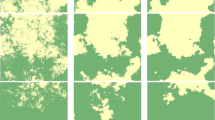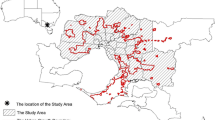Abstract
The processes of urbanisation have left a fragmented mosaic of habitat patches of varying size, shape and character with the result that from location to location the number and quality of contacts between patches varies considerably. Traditional measurements of this habitat fragmentation, and its converse, connectivity, have rarely looked at the landscape as a whole but instead have simplified it to specific landscape subsets, or else have looked at area-to-area relationships through generalising the landscape into homogeneous pixels or grids. In this paper the character of the whole landscape is examined at scales appropriate to the spatial variability of the urban environment. Using a direct measurement of patch-to-patch contact all contacts between all patches are examined and the relationship between all contiguous and connecting habitats is quantified. This is further refined to look at connections between patches of different quality, a measure that highlights the adverse effects of urbanisation as a whole on landscape connections between quality habitats.
Similar content being viewed by others
References
Ahern, J. 1995. Greenways as a planning strategy. Landsc. Urban Planning 33: 131–155.
Andrén, H. 1994. Effects of habitat fragmentation on birds and mammals in landscapes with different proportions of suitable habitat: a review. Oikos 71: 355–366.
Barker, G.M.A. 1997. A framework for the future: green networks with multiple uses in and around towns and cities. English Nature Research Report No. 256, English Nature, Peterborough.
Beier, P. and Noss, R.F. 1998. Do habitat corridors provide connectivity? Cons. Biol. 12: 1241–1252.
Collinge, S.K. 1996. Ecological consequences of habitat fragmentation: implications for landscape architecture and planning. Landsc. Urban Planning 36: 59–77.
Dawson, D. 1994. Are habitat corridors conduits for animals and plants in a fragmented landscape? A review of the scientific evidence. English Nature Research Report No. 94, English Nature, Peterborough, UK.
Dawson, K.J. 1995. A comprehensive conservation strategy for Georgia's greenways. Landsc. Urban Planning 33: 27–43.
Doak, D.F., Marino, P.C. and Kareiva, P.M. 1992. Spatial scale mediates the influence of habitat fragmentation on dispersal success: implications for conservation. Theor. Popul. Biol. 41: 315–336.
Hardy, P. and Dennis, R. 1997. Butterfly range-extension into Greater Manchester: the role of climate change and habitat patches. Urban Nature Mag. 3: 6–8.
Forman, R.T.T. 1995a. Land Mosaics: the Ecology of Landscapes and Regions. Cambridge University Press, Cambridge, UK.
Forman, R.T.T. 1995b. Some general principles of landscape and regional ecology. Landsc. Ecol. 10: 133–142.
Gilbert, O.L. 1989. The Ecology of Urban Habitats. Chapman & Hall, London, UK.
Goode, D.A. 1989. Urban nature conservation in Britain. J. Appl. Ecol. 26: 859–873.
Jaeger, J.A.G. 2000. Landscape division, splitting index, and effective mesh size: new measures of landscape fragmentation. Landsc. Ecol. 15: 115–130.
Janssens, P. and Gulnick, H. 1988. Connectivity, proximity and contiguity in the landscape interpretation of remote sensing data. In Connectivity in Landscape Ecology. Proceedings of the 2nd International Seminar of the International Association for Landscape Ecology. pp. 43–48. Edited by K.F. Schreiber. Münstersche Geographische Arbeiten, Münster, Germany.
Johnson, L.B. 1990. Analyzing spatial and temporal phenomena using GIS (a review of ecological applications). Landsc. Ecol. 4: 31–43.
Johnson, C.W. 1995. Planning and designing for the multiple-use role of habitats in urban/suburban landscapes in the Great Basin. Landsc. Urban Planning 32: 219–225.
Knight, T.W. and Morris, D.W. 1996. How many habitats do landscapes contain? Ecology 77: 1756–1764.
Kovár, P. 1995. Is plant community organization level relevant to monitoring landscape heterogeneity? Two case studies of mosaic landscapes in the suburban zones of Prague, Czech republic. Landsc. Urban Planning 32: 137–151.
Kozová, M., Smitalova, K. and Vizyova, A. 1986. Use of measures of network connectivity in the evaluation of ecological landscape stability. Ekologia (Czechoslovakia) 5: 187–202.
Linehan, J., Gross, M. and Finn, J. 1995. Greenway planning: developing a landscape ecological network approach. Landsc. Urban Planning 33: 179–193.
McDonnell, M.J. and Pickett, S.T.A. 1988. Connectivity and the theory of landscape ecology. In Connectivity in Landscape Ecology. Proceedings of the 2nd International Seminar of the International Association for Landscape Ecology. pp. 17–22. Edited by K.F. Schreiber. Münstersche Geographische Arbeiten, Münster, Germany.
Metzger, J.-P. and Décamps, H. 1997. The structural connectivity threshold: an hypothesis in conservation biology at the landscape scale. Acta Oecologica 18: 1–12.
Moilanen, A. and Hanski, I. 1998. Metapopulation dynamics: effects of habitat quality and landscape structure. Ecology 79: 2503–2515.
Nature Conservancy Council (1990) Handbook for Phase-1 Habitat Survey — a Technique for Environmental Audit. N.C.C., Peterborough, UK.
Pither, J. and Taylor, P.D. 1998. An experimental assessment of landscape connectivity. Oikos 83: 166–174.
Rebele, F. 1994. Urban ecology and special features of urban ecosystems. Global Ecol. Biogeogr. Lett. 4: 173–187.
Riiters, K.H., O'Neill, R.V. and Jones, K.B. 1997. Assessing habitat suitability at multiple scales: a landscape-level approach. Biol. Cons. 81: 191–202.
Schiller, A. and Horn, S.P. 1997. Wildlife conservation in urban greenways of the mid-southeastern United States. Urban Ecosys. 1: 103–116.
Schippers, P., Verboom, J., Knaapen, J.P. and van Apeldoorn, R.C. 1996. Dispersal and habitat connectivity in complex heterogeneous landscapes: an analysis with a GIS-based random walk model. Ecography 19: 97–106.
Schumaker, N.H. 1996. Using landscape indices to predict habitat connectivity. Ecology 77: 1210–1225.
Sisinni, S.M. and O'Hea-Anderson, M. 1993. Methods and results of natural resource assessments in New York City, New York. Landsc. Urban Planning 25: 95–114.
Sukopp, H., Kunick, W. and Schneider, C. 1980. Biotope mapping in the built-up areas of West Berlin II. Garten und Landschaft 7/80: 565–569.
Szacki, J., Glowacka, I., Liro, A. and Matuszkiewicz, A. 1994. The role of connectivity in the urban landscape: some results of research. Memorabilia Zoologica 49: 49–56.
Thomas, C.D. 1995. Ecology and conservation of butterfly metapopulations in the fragmented British landscape. In Ecology and Conservation of Butterflies. pp. 46–64. Edited by A.S. Pullin. Chapman and Hall, London, UK.
Turner, M.G. 1990. Spatial and temporal analysis of landscape patterns. Landsc. Ecol. 4: 21–30.
Veitch, N., Webb, N.R. and Wyatt, B.K. 1995. The application of Geographic Information Systems and remotely sensed data to the conservation of heathland fragments. Biol. Cons. 72: 91–97.
Wilcove, D.S., McLellan, C.H. and Dobson, A.P. 1986. Habitat Fragmentation in the temperate zone. In Conservation Biology. pp. 237–256. Edited by M.E. Soulé. Sunderland, Massachusetts, Sinauer, USA.
With, K.A., Gardner, R.H. and Turner, M.G. 1997. Landscape connectivity and population distributions in heterogeneous environments. Oikos 78: 151–169.
Wittig, R. and Schreiber, K-F. 1983. A quick method for assessing the importance of open spaces in towns for urban nature conservation. Biol. Cons. 26: 57–64.
Young, C.H. and Jarvis, P.J. (in press) A simple method for predicting the consequences of land-management in urban habitats. Environ. Manag.
Author information
Authors and Affiliations
Corresponding author
Rights and permissions
About this article
Cite this article
Young, C.H., Jarvis, P.J. Measuring urban habitat fragmentation: an example from the Black Country, UK. Landscape Ecology 16, 643–658 (2001). https://doi.org/10.1023/A:1013108005347
Issue Date:
DOI: https://doi.org/10.1023/A:1013108005347




